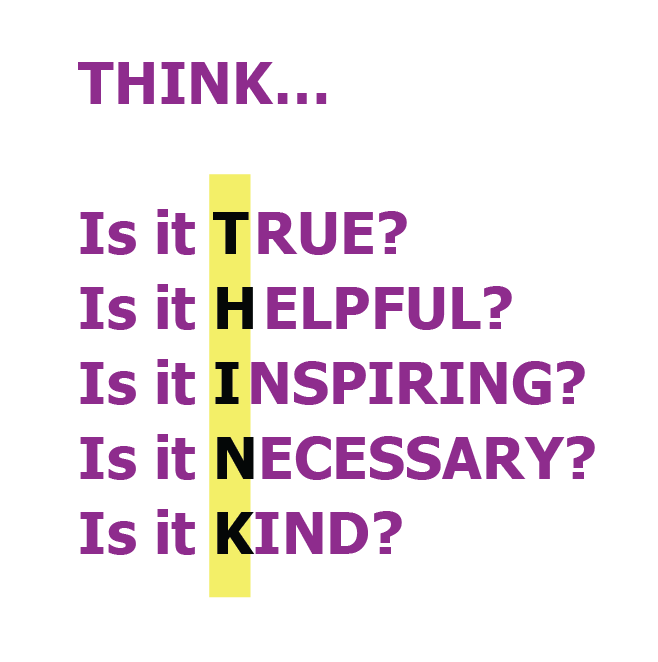
MODULE 3:
Digital Footprint or Digital Tattoo
Twitter is an invaluable way to help learners to understand the significance of creating a quality digital footprint. Remind students that everything posted online is searchable and recoverable, as this will help them to understand the importance of being extremely cognizant of their choices with all social media, not solely with Twitter.
Helping students to understand the importance of posting accurate information and showing them how to fact-check to be sure what they are sharing is true, is also a critical part of using Twitter and other social media applications in a positive way.
Remind learners to use the following as a guide:

This acronym will help students to navigate Twitter (as well as other social media spaces) in a responsible way. When unsure about the answer to any of the above questions, a learner should know to pause, back up, and rethink before posting. As a mentor, be sure to guide them to check sources and read the entire article before sharing. Remind them the importance of context. Make informed decisions about what is viewed on Twitter to have the best experience.
Here are some additional suggestions and opportunities to help your learners be good digital citizens.
-
Discuss the differences between privacy and security. Both are extremely important, but sometimes students might be unaware of the differences and why they are a critical part of using social media, including Twitter, in a responsible way. Other important topics include digital access, etiquette, commerce, rights and responsibilities, literacy, law, and communication.
Privacy — The protection that an individual has while using the Internet
Security — Protection from and resilience against potential harm through social media
Digital Access — The ability to participate fully in a digital society
Etiquette — A set of conventional and unconventional rules of both personal and business behavior online
Commerce — The process of selling products directly through social media
Rights and Responsibilities — Obey intellectual property laws and rules of media and copyright, and report inappropriate actions like cyberbullying and threats.
Literacy — The ability to access and analyze media messages
Law — A balance of the freedom of expression and constraints set in place by common law
Communication — Act of giving, receiving, and sharing information on social media
- Incorporate lessons in digital citizenship during teachable moments. It does not have to necessarily be taught as a separate topic, and will often be more meaningful and impactful when students understand its importance in the moment.
- For elementary learners, relate the topics of communities and community helpers to digital citizenship by helping students to understand the important jobs that exist in digital spaces which help the community to run safely and successfully.

- Consider referring to a “digital tattoo” rather than a “digital footprint,” because footprints can be washed away, and tattoos are more permanent, much like social media posts and other content.
- Avoid creating fear, and rather show students the ways in which Twitter and other social media platforms are ways to help make a positive impact on others all over the world.
The Lifespan of a Tweet
You might be wondering what happens once your tweet posts to Twitter. Understanding the lifecycle of a tweet can help you to be successful with and utilize Twitter in the best ways possible for your needs and learning goals.
Twitter is one of the fastest-paced social media networks, and approximately 6,000 new tweets post per second! A tweet has an average lifespan of about fifteen minutes. That may not seem like a long time, but you will be surprised at the traction that a tweet can gain in that time period. By understanding how tweets work successfully, you will be able to build a following, interact substantively with your followers and those you follow, and learn a ton along the way!
One of the biggest factors in a successful tweet is the number of retweets that it has. Because a retweet exposes a tweet to an entirely new audience, this is the best way for it to reach even more people all across the world. Retweets also lead to more retweets, expanding a tweet’s lifespan to about eighteen minutes. Retweets upon retweets can lead to a post going viral, another reason to ensure that the content you are sharing is accurate and well-thought out. You never know how far it might reach! Tweets that have not gained much interaction quickly fall down the list and may go unnoticed.
Check in on Twitter a few times a day, and aim to post at least once or twice daily. Infuse personality into your tweets and promote others. Give credit in an appropriate way, and as you share relevant information, you will also be helping other fellow educators to connect and find valuable resources for their own learning and classroom use along the way.
